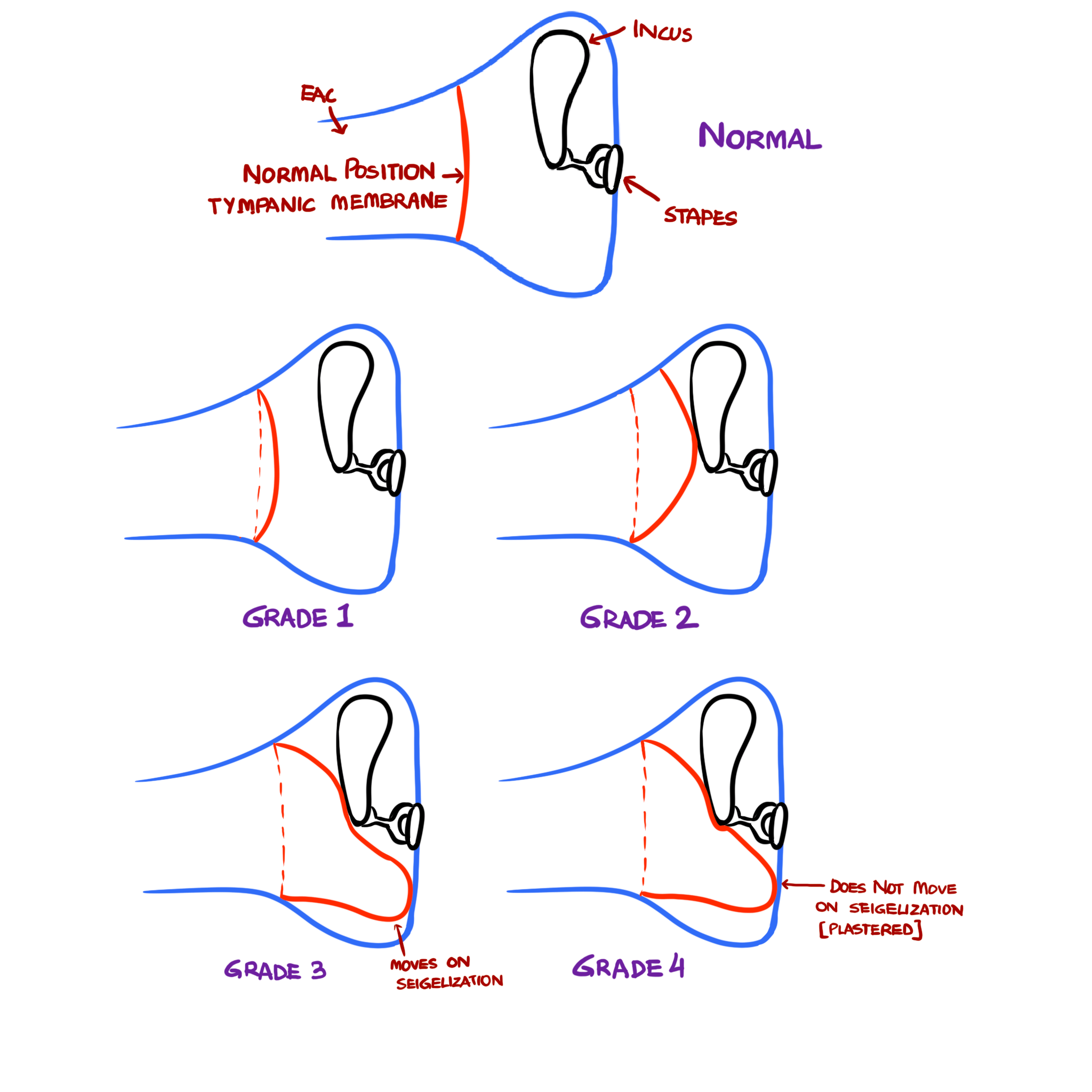Sade Classification - Pars Tensa Retraction
💡 The post below is just an outline of the YouTube video and my notes. For the full content, please purchase the notes using the links above.
🩺 Sade's Classification of Pars Tensa Retraction

✅ Grade 1: Mild Retraction
- Minimal retraction of the tympanic membrane.
- Not in contact with the incus or any other middle ear structures.
- Loss of light reflex seen.
- Tympanic membrane still mobile.
✅ Grade 2: Contact with Ossicles
- Tympanic membrane now touches the long process of incus or stapes.
- Ossicular structures may appear more prominent on endoscopy.
✅ Grade 3: Middle Ear Atelectasis
- Retraction becomes severe, and the tympanic membrane is now in contact with the promontory.
- Key feature: The membrane still moves with Valsalva or suctioning (reversible atelectasis).
✅ Grade 4: Adhesive Otitis Media
- Tympanic membrane is plastered to the promontory.
- No movement on Valsalva or suctioning.
- Represents irreversible adhesive otitis media.
🔁 Grade 3 vs Grade 4 – Key Difference
| Feature | Grade 3 | Grade 4 |
|---|---|---|
| Contact | Tympanic membrane touches promontory | Tympanic membrane touches promontory |
| Movement on Valsalva | ✅ Present (moves) | ❌ Absent (plastered) |
| Also Known As | Middle ear atelectasis | Adhesive otitis media |
📌 Summary
The SADE classification gives insight into the severity and reversibility of pars tensa retraction:
- Early grades are mild and reversible.
- Later grades indicate more severe, potentially permanent damage.
Understanding and being able to draw and explain each stage is crucial for clinical practice and ENT exams.
~~~~~~~~
📝 All the topics and questions mentioned in this post are explained in detail in my ENT notes - built for exam success and clinical understanding. Get full access by purchasing the notes.
~~~~~~~~
Related ENT Notes & Lectures
Abscesses in relation to Mastoid
Acute Mastoiditis VS Furunculosis
Acute Necrotizing Otitis Media
Acute Otitis Media - Causes, Symptoms and Treatment
Anatomy of External Ear
Anatomy of Facial Nerve
Anatomy of Facial Nerve – Branches
Anatomy of Facial Nerve – Functional Components
Anatomy of Facial Nerve – Nuclei & Course
Anatomy of Inner Ear
Anatomy of Middle Ear - Contents
Anatomy of Middle Ear - Walls & Parts
Anatomy of Tympanic Membrane
Canal wall Down VS Canal wall Up Mastoidectomy
Cholesteatoma
Chronic Suppurative Otitis Media (CSOM)
Complications of Acute Otitis Media
Complications of CSOM
Complications of Mastoidectomy
Cortical Mastoidectomy
Extracranial Complications of CSOM
Gradenigo Syndrome
How to Draw a Normal Tympanic Membrane
How to Draw Tympanic Membrane Perforations
Inner Ear fluids - Perilymph and Endolymph
Inside out VS Outside in Mastoidectomy
Labyrinthine Fistula
Labyrinthitis
Landmarks of Facial Nerve in Mastoid and Parotid surgeries
Malignant Otitis Externa (Skull Base Osteomyelitis)
Mastoiditis
Modified Radical Mastoidectomy
Organ of Corti – Anatomy, Structure and Clinical Relevance
Otogenic Brain Abscess
Petrositis
Radical Mastoidectomy
Referred Pain in the Ear
Sigmoid Sinus Thrombosis
Tos Classification - Pars Flaccida Retraction
Tympanoplasty Part 1 - Definition, Types, Grafts, Indications, Contraindications
Tympanoplasty Part 2 - Approaches, Techniques, Steps & Complications
Types of Tympanoplasty - Wullstein Classification
Brodsky Grading of Tonsillar Enlargement
Indirect Laryngoscopy Diagram - How to Draw and Label
Relations of Hyoglossus Muscle